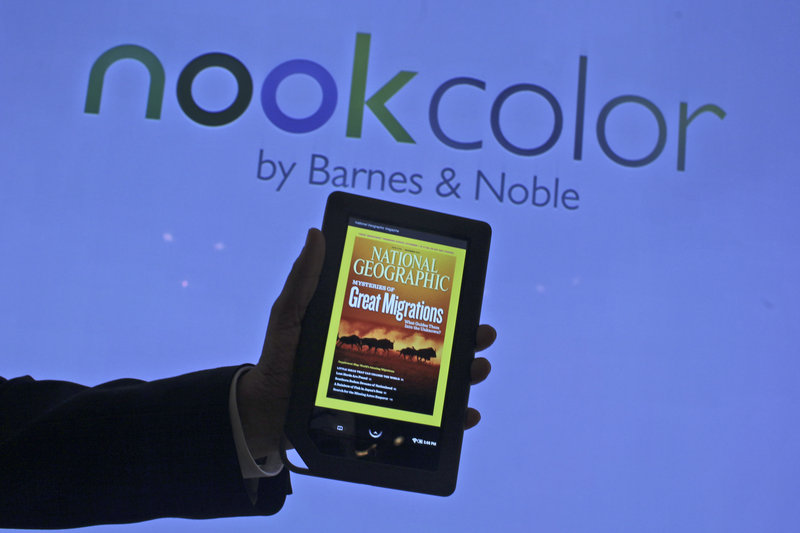NEW YORK – This isn’t supposed to be the year of the color-screen e-reader. Led by Amazon.com’s Kindle, monochrome readers have just burst into the mainstream. Color? Not until at least 2011, unless you’re willing to pay a lot more for a full-fledged tablet computer like Apple’s iPad or Samsung’s Galaxy Tab.
Well, Barnes & Noble didn’t get the memo. Its new $249, Wi-Fi-enabled Nook Color reader is on sale now, and provides a satisfying reading experience for half the cost of a tablet.
That’s surprising, because I wasn’t a fan of the original Nook, an agonizingly slow and buggy Kindle knock-off, when it debuted a year ago. It’s improved since then, though it still hasn’t caught up to the Kindle.
By contrast, the Nook Color, with its bright backlit screen and touch interface, has beaten Amazon to the punch. Not to mention Sony, which pioneered the e-reader but remains mired with a line of handsome yet overpriced monochrome devices.
Given the tradeoffs that the Nook Color requires in terms of price — the Kindle starts at $139 — weight and battery life, the first question has to be: Is color really worth it? It depends on what type of books you read. If it’s mostly fiction — just words on a page — then either color or the E Ink monochrome display used in the Kindle, Sony Reader and original Nook will do the job.
Color, though, is far more satisfying for nonfiction, art and children’s books, whose photos and other illustrations lose their punch when rendered on monochrome screens. It’s better for magazines too, and the liquid-crystal display technology used in the Nook Color and iPad also allows video to be incorporated more easily.
China’s Hanvon Technology recently announced it will start selling a reader using a color version of E Ink next year, and Qualcomm says its Mirasol color technology is on the way too.
Barnes & Noble, though, has opted to use a 7-inch LCD from Korea’s LG Display. At 8.1 inches tall, 5 inches wide and .48 inches thick, the Nook Color is marginally larger than the Kindle but still slips into a jacket pocket.
The biggest difference is in the weight: The Nook Color is 15.8 ounces, almost twice as heavy as the Kindle.
The device the Nook most resembles in size and weight is Samsung’s Galaxy Tab iPad-competitor.
Both run Google’s Android operating system, though the Nook’s version has been customized to make it feel less like an overgrown smartphone. The Nook is also thinner and sleeker than the Galaxy.
Barnes & Noble has done a good job revamping the Nook’s interface to take advantage of the color version’s touch capabilities.
There are multiple ways of accessing your library, including a scrolling display of up to 50 covers on the home screen and a “Keep Reading” icon that automatically returns you to your most recently viewed book or periodical.
You turn pages either by tapping or swiping the screen. Pressing and holding the screen for two seconds opens pop-up menus that allow you to annotate a passage, look up a word or term in the built-in dictionary or connect to the Internet for more information.
Oh, and add the Internet to the list of things the Nook Color does better than monochrome e-readers. Its built-in browser makes the Web look like the Web, while the touch screen makes it much easier to navigate than on most digital-ink readers.
The Android operating system enables the Nook Color to run apps, and several are built in, including a music player, Pandora Internet radio, a contact manager and a few games.
Barnes & Noble says more apps will follow, but will be limited to those that complement or enhance the reading experience.
The company says it has no plans to open the Nook Color to the broader universe of Android apps: This is a device aimed at readers, not a stealth iPad-killer.
Besides weight and cost, the Nook’s biggest drawback compared with digital-ink readers is battery life. It claims eight hours, which is good for a color LCD tablet, but far less than the Kindle, which can go a month between charges.
There are other issues as well. In my tests, the Nook Color would occasionally jump forward a few pages on its own while I was reading.
In addition, while the device is capable of reorienting itself from portrait to landscape view when you turn it, Barnes & Noble inexplicably prevents you from doing so for some books.
All backlit screens, the Nook Color’s among them, are harder to read in direct sunlight than are digital-ink devices.
On the other hand, they are easier to read at night, since they don’t require an external light source.
In the end, if all you want from an e-reader is words, the Kindle is still the class of the field. But if you’re looking for a richer and more book-like experience, Barnes & Noble has jumped out in front.
Rich Jaroslovsky is a Bloomberg News columnist.
Send questions/comments to the editors.



Success. Please wait for the page to reload. If the page does not reload within 5 seconds, please refresh the page.
Enter your email and password to access comments.
Hi, to comment on stories you must . This profile is in addition to your subscription and website login.
Already have a commenting profile? .
Invalid username/password.
Please check your email to confirm and complete your registration.
Only subscribers are eligible to post comments. Please subscribe or login first for digital access. Here’s why.
Use the form below to reset your password. When you've submitted your account email, we will send an email with a reset code.